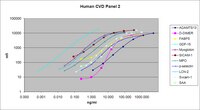Systemic treatment and narrowband ultraviolet B differentially affect cardiovascular risk markers in psoriasis.
Sigurdardottir, G; Ekman, AK; Ståhle, M; Bivik, C; Enerbäck, C
Journal of the American Academy of Dermatology
70
1067-75
2014
Zobrazit abstrakt
Psoriasis is associated with a systemic inflammation and an increased frequency of the metabolic syndrome, both of which are believed to link psoriasis to an increased risk of cardiovascular disease.The study aimed to investigate the systemic expression of markers of cardiovascular risk and determine their response to ultraviolet B therapy and treatment with the tumor necrosis factor-alfa inhibitor, etanercept.Six markers of cardiovascular risk were measured in 28 patients with psoriasis and 28 control subjects.Five of the 6 investigated markers were elevated in patients with psoriasis. Four of these correlated to the body mass index and waist-hip ratio, suggesting a link to the metabolic syndrome. Total plasminogen activator inhibitor-1 remained elevated independently of these factors. The levels of the investigated risk markers decreased considerably after tumor necrosis factor-alfa inhibitor treatment but remained unaffected by ultraviolet therapy.A relatively limited study population and nonrandomization are limitations.These findings suggest that the choice of treatment in psoriasis may influence the cardiovascular risk in patients with psoriasis and the metabolic syndrome. | 24656729
 |
Effect of natalizumab on oxidative damage biomarkers in relapsing-remitting multiple sclerosis.
Tasset, I; Bahamonde, C; Agüera, E; Conde, C; Cruz, AH; Pérez-Herrera, A; Gascón, F; Giraldo, AI; Ruiz, MC; Lillo, R; Sánchez-López, F; Túnez, I
Pharmacological reports : PR
65
624-31
2013
Zobrazit abstrakt
Natalizumab is a monoclonal antibody used to treat multiple sclerosis. This study sought to determine whether the protective action of natalizumab involved a reduction in oxidative damage.Twenty-two multiple sclerosis patients fulfilling the revised McDonald criteria were assigned to treatment with 300 mg natalizumab intravenously once monthly (infusion every 4 weeks) in accordance with Spanish guidelines. Carbonylated proteins, 8-hydroxy-2'-deoxyguanosine, total glutathione, reduced glutathione, superoxide dismutase, glutathione peroxidase, and myeloperoxidase levels were measured at baseline and after 14 months' treatment, and the antioxidant gap was calculated.Natalizumab prompted a drop in oxidative-damage biomarker levels, together with a reduction both in myeloperoxidase levels and in the myeloperoxidase/neutrophil granulocyte ratio. Interestingly, natalizumab induced nuclear translocation of Nrf2 and a fall in serum vascular cell adhesion molecule-1 levels.These findings suggest that natalizumab has a beneficial effect on oxidative damage found in MS patients. | 23950585
 |









